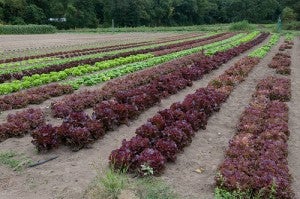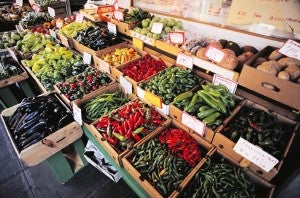
Credit: Flickr user Dwight Sipler
What comes to mind when you think of a “family farm?” You’re probably picturing a bucolic spread of less than 100 acres, with a red barn, farmer in overalls, and cows grazing a big pasture. What about the phrase “corporate farm” or “big ag?” Do you see a giant, impersonal and industrial-looking operation?
Unfortunately, these common (mis)perceptions are regularly promoted in everything from TV ads to online chats. But the reality is that “big” does not equate to “bad,” and “small” doesn’t necessarily mean “good” when it comes to sustainable farming. In fact, it’s the wrong debate altogether.
What really matters is performance, not size.
Today is National Agriculture Day, celebrated annually on March 18, and this year’s theme is sustaining future generations. If we’re going to meet the needs of a rapidly growing population, we’re going to need large and small farms alike. And no matter their size, they’ll need to minimize their impacts on the natural systems that sustain us all.
Addressing the myth
It’s a myth that large farms can’t be sustainable, just as it’s a myth that all family farms are small and better for the environment.
Take Christine Hamilton, for example, whose family farm produces corn, soybeans, winter wheat and cattle across 14,000 acres in South Dakota. For years she’s been participating in USDA conservation programs, using no-till practices, planting trees to limit erosion, and utilizing variable rate technologies to improve the environment and her yields.
There are also places like Fair Oaks Farms, which milks over 500 cows … an hour. To make their large operation more sustainable, Fair Oaks pumps methane from its livestock to an on-site natural gas station that compresses it into fuel for the farm’s fleet of 40 milk trucks.
Many small-farm operations implement sustainable practices as well. A perfect example is Full Belly Farms, a 400-acre organic farm in Northern California that won last year’s prestigious Leopold Conservation Award. But I’ve visited small farms where livestock roam freely into streams, soil erosion destroys riverbanks, and nutrient management plans are nonexistent.
In the U.S., agriculture already occupies 51 percent of our land, uses 80 percent of our water, and is responsible for 8 percent of our greenhouse gas emissions. And in the coming decades U.S. farms will be responsible for producing even more food. In order to make agriculture a plus for the environment, farm practices will need to change.
Of course, we have to keep in mind the context here. Mid-size and large-scale family farms account for 8 percent of U.S. farms but 60 percent of the value of production, so in order to bring sustainable agriculture to scale, they will have to do the bulk of the work. But small farms have a much higher share of production for specific commodities in the U.S. – they account for 56 percent of domestic poultry production, for example – so we’ll need their leadership, too.
Regardless of size, all farms need to:
- Minimize the loss of nutrients and soil to air and water through nutrient optimization strategies such as conservation tillage.
- Use water as efficiently as possible.
- Improve soil health through strategies such as cover crops.
- Avoid plowing up ecologically important lands.
- Fence livestock out of streams and implement management plans to maintain healthy grazing lands and avoid overgrazing
- Use strategically placed filters to capture excess nutrients.
It’s time we shift the public debate and get everyone on board the sustainability train. Arguing about a farm’s size won’t deliver environmental benefits. In the end, it’s all about performance.











3 Comments
Great Article!
May I please post this on our website with attribution to Christine Hamilton, Environmental Defense Fund?
Thank you.
Sincerely,
Laurie Greene
CaliforniaAgToday@yahoo.com
cell: 530-304-3455
It is a myth that large farms can not be sustainable? Could be. Let us put it to the test. End government support of big farms. End government support of all farms so as to have a level farming field. End the USDA and send employees into the field, either in agriculture or other sectors of the economy. If large farms are then sustained, then they will have passed a first market test since the New Deal.
Ernest Martinson,
I’m all for rational reform of farm policy. I’m against the ethanol mandate and I don’t think that commodity crops need special policy support any longer.
But the evidence pretty clearly shows, that as you withdraw government support, smaller farmers are more vulnerable, farms consolidate and large farms dominate the market.
This is what happened during the farm crisis in the 1980’s after farm policy was liberalized in the 1970’s and this is why emergency payments were passed after the Freedom to Farm Act of 1996.
The bulk of subsidies may flow to the largest farms (they are usually based on acres or harvest after all) but they impact and help small and medium sized farms the most.
I’m all for getting rid of them (with a plan), but don’t have any illusions about what’s going to happen. We will see more consolidation as we have every time policy allows for more markets and less government involvement.